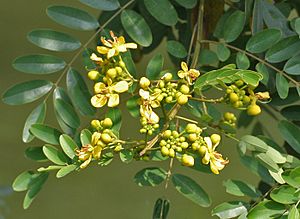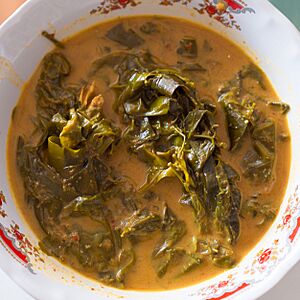Siamese cassia facts for kids
Quick facts for kids Siamese cassia |
|
|---|---|
 |
|
| Scientific classification | |
| Genus: |
Senna
|
| Species: |
siamea
|
| Synonyms | |
|
|
The Senna siamea is a type of tree known by many names, including Siamese cassia, kassod tree, and cassia tree. It belongs to the legume family, which includes plants like peas and beans.
This tree originally comes from South Asia and Southeast Asia, but exactly where it first grew is a bit of a mystery.
It's a medium-sized tree that stays green all year. It can grow quite tall, up to 18 meters (about 59 feet), and has pretty yellow flowers. People often plant it to provide shade for crops like cocoa, coffee, and tea. In Thailand, the Senna siamea is a special tree for Chaiyaphum Province, and some places in the country are even named after it!
The leaves of this tree grow in a special way. They are arranged in pairs along a stem, with 6 to 12 pairs of small leaves on each stem. These leaves are rounded at both ends and have a slight reddish-green color.
Contents
What is the Senna siamea used for?

The Senna siamea tree is useful in many ways. It has been used in traditional medicine and contains a special compound called barakol.
The leaves, young pods, and seeds of this tree can be eaten. However, it's important to boil them first and throw away the water before eating. This helps to remove any bitter taste or unwanted substances.
In Myanmar and Thai cuisine, these parts of the tree are used in delicious dishes. One famous Thai dish is kaeng khilek, which is a type of curry.
In Myanmar, during the full moon day of Tazaungmon, families often pick the buds of the Siamese cassia flowers. They use them to make a tasty salad called mezali phu thoke or a warm soup.
Other uses of the Kassod tree
Besides food, the Senna siamea tree is also used for other things.
- It can be used as fodder for animals, meaning it's food for them.
- Farmers sometimes plant it between other crops to help the soil.
- It's also used to create windbreaks, which are rows of trees that protect fields from strong winds.
The wood of the Senna siamea is very strong and beautiful. It's known as pheasantwood or polohala because its grain looks a bit like the feathers of a pheasant. This special wood is used to make musical instruments, like ukuleles and guitars, and other decorative items. In China, this wood is sometimes called jichimu and is used for making fancy furniture.
Different names for the Senna siamea
People in different countries have their own names for the Senna siamea tree:
- In Myanmar, it's called Burmese: မယ်ဇလီ, or mezali.
- In Thailand, it's known as Thai: ขี้เหล็ก, or khilek.
- In Vietnam, it's called Vietnamese: muồng đen.
- In the Twi language, it's called Nkyedua.
- In the Ewe language, it's called Zangara gbe.
See also
 In Spanish: Senna siamea para niños
In Spanish: Senna siamea para niños


